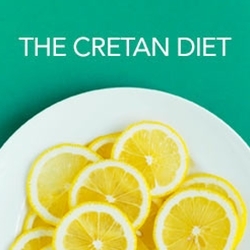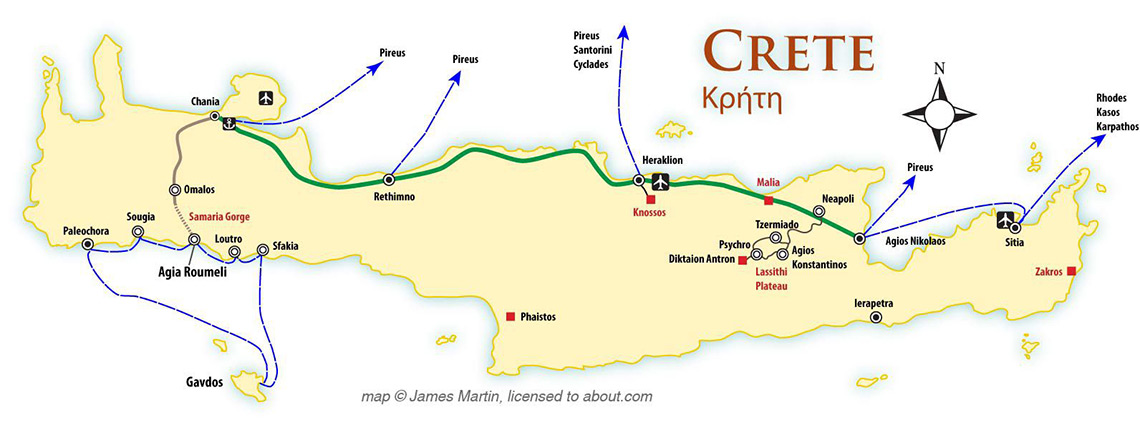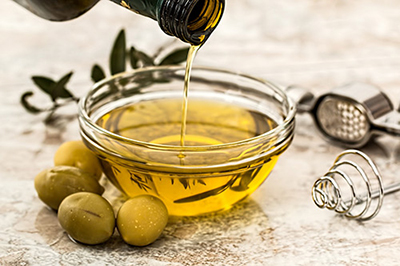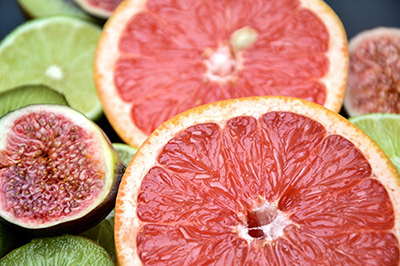The Cretan Diet - The Original Mediterranean Diet

The Mediterranean diet has been recognized for decades as a pillar of healthy living. This diet pulls from the 22 countries in the region surrounding the Mediterranean Ocean, emphasizing the consumption of olive oil, fresh fruits and vegetables, some fish, and small amounts of meat.
The modern-day Mediterranean Diet is described as being a combination of Greek, Italian, and Spanish cuisines. The diet emerged from a the "Seven Countries Study", which was begun in the 1950s. The study was led by Ancel Keys, a physiologist from the University of Minnesota who was dedicated to learning about and combating the heart related health issues that were beginning to plague Americans. He discovered that the island of Crete, pronounced "kreet," was was the healthiest of the countries in his study, with incidences of heart disease occurring at extraordinarily low percentages among the Cretan population. The population of Crete tends to eat seasonally and locally, consuming between 9-12 servings of fruits and vegetables a day, as well plenty of olive oil. This is the only oil they use--there's no butter, no lard--and it makes up to 37% of their daily caloric intake.
While there are aspects of his study that have earned criticism, longitudinal follow-up shows that adherence to the Mediterranean Diet in general, and the Cretan Diet in particular, has resulted in active and vital seniors. Those who adopted a more Western diet pattern saw a rise in heart disease, and other corollary diseases like dementia.
About Crete
Of Greece's 1,400 islands, only 230 are inhabited. Crete is the largest of these Islands, and it is the fifth largest island overall in the Mediterranean Sea. The island is just south of mainland Greece, putting it at about 250 miles from Athens, Greece. It is southwest of Turkey and north of both Libya and Egypt.

The cultural history of Crete goes back to 8,000 BCE, predating even the ancient Crete Minoan civilization, the first civilization in Europe, by more than four thousand years. The archaeological record of Crete includes superb palaces, houses, roads, paintings and sculptures. Early Neolithic (10,200BCE to 2,000BCE) settlements in Crete include Knossos, which is thought to be Europe's oldest city, and the Cave of Trapeza. Archaeological digs in Southern Crete in 2008-2009 uncovered the most primitive stone tools from the Paleolithic period, a time that dates back to roughly 130,000 years ago. Crete is also the legendary birthplace of Zeus, the sky and thunder god in ancient Greek mythology, who ruled as King of the Gods on Mount Olympus.
For thousands of years Cretans have eaten only what their land produced; lots of fruits, vegetables, olives, whole grains and the dried seeds of legumes such as beans, lentils and peas called pulses. Cretans consume a great deal of olive oil, significantly more than any other Mediterranean people and they don't use any other type of oil. The meat in their diet is a very small factor, as they are more focused on fruits and vegetables.
Ancel Key's Study and What We Know Now
Understanding the back story behind the original research of the Seven Country Study is to discover that it didn't turn out as expected. It starts with the lead researcher Ancel Keys, who was a professor and director of the Laboratory of Physiological Hygiene at the University of Minnesota from 1940-1972. Keys made a name for himself in 1941, when he was assigned by the US War Department to help feed front line WWII soldiers for short durations. He ended up creating the K-ration. The K-rations were three separately boxed meals, one for each breakfast, lunch, and dinner that were lightweight at only about 28 ounces each and were designed to provide essential energy to the soldiers. Essential energy intake of a WWII soldier was about 2,830 to 3,000 calories per meal. The Army had unsuccessfully tested 4 earlier versions of daily rations known as A-ration, B-ration, C-ration, and D-ration. It is said that Key's ration was called K-ration as a nod to his last name.
Keys officially began his Seven Country Study in 1957, but he had begun gathering data in 1947 shortly after the end of WWII. The findings of this extensive study were not released until 1972. The research was a multi-country study that systematically examined the relationships between lifestyle, diet and coronary heart disease in different populations from different regions of the world. The study surveyed rural men 40 to 59 years old from 1958 to 1970. The researchers choose regions in each of these countries where the traditions of daily living were much the same as they had been for centuries. This allowed an accurate analysis of typical diets and lifestyles. The seven countries in the study were America, Finland, the Netherlands, Italy, Greece, Yugoslavia and Japan. The research found that East Finland had the highest rates of heart disease deaths at 171 deaths per thousand, the US had 92 deaths, Italy 24, Japan 13 and the Greek island of Crete had an almost unbelievable 3 deaths per thousand.? An international team had conducted some early surveys in remote villages in Italy, and they wanted to see if similar work could be done in villages in other countries. In 1957, Dr. Andy Dontas and Dr. Christ Aravanis, a leading cardiologist in Athens, proposed conducting the study in villages on the island of Crete.
Crete was chosen as instances of coronary heart disease were reportedly quite rare and the researchers had been told of farmers still working at 100 years of age. This proved to be an ideal setting to test a population with a relatively high fat diet made up of high monosaturated and low saturated fatty acids. The researchers initially studied 13 villages in Kastelli Pediada county and the subjects were 657 men aged 45-64. The results of the surveys were astonishing - as only 2 cases of myocardial infarction were found. In a similar population, in America there would have been at least 10 cases for the same number of subjects. The diet was odd compared to other countries in the study, as almost 40% of the total calories came from fats. They found many farmers started their day by drinking between a shot and cupful of olive oil. In retrospect we can now see that the original research of the Cretan diet revealed a natural rhythmic pattern of food consumption, meaning only food that was in season and available directly on the island was consumed. Thus, the people of Crete were consuming a much more nutritionally complex diet that isn't easily replicated outside of this area, especially considering that some of the wild greens they eat don't grow outside of the island.
Based on diet, some countries like Finland in the study did far worse than expected, with heart attacks higher than mean cholesterol values. Other countries, specifically the island of Crete was much lower than predicted. Scientists today argue that Keys cherry picked data to support his hypothesis, noting that countries that fit his criteria but didn't fit the desired outcome were specifically excluded. Still, the observations of the health benefits of this diet should not be left to the wayside. It is obvious that eating like a Cretan is better for heart health than the standard American diet, even if this study has since been more thoroughly scrutinized and found to be less factual than originally thought.
The Overview of the Cretan Diet
During this research, it was found that the men of rural Crete consumed significant amounts of olive oil, olives, fruits, nuts and vegetables, especially wild greens. They consumed moderate amounts of fish, cheese and red wine. Very small amounts of eggs, meat and milk were consumed. The essence of their diet was abundant amounts of antioxidants, fiber, omega-3 fatty acids, vitamins E and C, phytochemicals and selenium. What was surprising to the researchers was that the Cretans had one of the highest fat diets with approximately 37% of their calories coming from fats. Most of this fat came from olive oil. They also consumed high amounts of omega-3 fatty acids from fish and large amounts of wild plants, snails, nuts, legumes and figs that were all high in ALA (Alpha-linolenic acid). The protein that was consumed from sources other than fish and legumes were free range chicken, eggs and some meats.
How to Eat Like You're in Crete!
While you can't forage for the same kinds of greens as you would be able to if you were in Crete, you can follow along with the basic guidelines of the diet and garner some health benefit. Cretan cuisine is one of foundation and simple, whole foods and flavors. There are not many complicated sauces or spices in this diet, though you can easily incorporate some Cretan elements to an already diverse diet that may incorporate more herbs, spices, and seasonings! Don't forget the olive oil too, something that many Cretans refer to as "liquid gold."
 Fat
Fat
Fat makes up about 35%-40% of daily calories in the Cretan diet. Cretans get their fat from olive oil and olives instead of animal fats. Various studies have found that Cretans had the highest intake of olive oil compared to other Mediterranean countries, with amounts that were significantly higher than what the Italians and Spaniards consumed. To place the importance of olive oil to the Cretan diet in perspective, consider that average olive oil consumption in Spain is 12 liters/person, Italy 11 liters/person and the US runs about 0.5 liter/person annually. In Crete, it's 25 liters per person per year.
Fruits and Vegetables
Consumption of seasonal fruits and vegetables is very high here. From November to April, grapefruit, lemons, oranges and tangerines are plentiful, in March mousmoula, a fruit similar to a nectarine, makes its first appearance. In June apricots and melons kick into gear, at the beginning of July apples, peaches and plums are found everywhere, in August black and green grapes take center stage. From September to October it's all about figs and pomegranates.
The consumption of vegetables is also high in Crete, but what really makes this aspect of the diet stand out is the wild greens. In Crete, you can find wild greens that do not grow anywhere else in the world, like wild stamnagathi. Studies have shown that these greens are good sources of omega-3 fatty acids, vitamin C and vitamin E. In Crete, greens are boiled and smothered in olive oil and lemon. They did consume vegetables that most of us are quite familiar with including artichokes, bell peppers, cabbages, chickpeas, cucumbers, green beans, grape leaves, leeks, okra, runner beans, small squashes, tomatoes and zucchini. Purslane is another vegetable familiar to us, but it is generally considered an exotic weed. It has more omega-3 fatty acids, alpha-linolenic acid in particular, than any other leafy vegetable plant, however, making it an especially healthy part of the Cretan diet. The average Cretan consumes 9 to 12 servings of fruits and vegetables each day compared to the current USDA recommendations of about 4.5 servings combined for Americans.
Grains and Potatoes
The main grains consumed in the Cretan diet are the whole grains barley and wheat in the form of bread, rolls and rusk. Bread is typically made from all barley or a combination of barley and wheat. Bread was eaten daily, usually with lots of olive oil, herbs, and sometimes cheese. Cretans also consume a wide variety of potatoes, rice and on occasion hilopites, a type of egg noodle.
Pulses
Cretans eat pulses on average 3 times a week. Pulses are part of the legume family, but the term "pulse" refers only to the dried seed. Pulses are very high in protein and fiber, but also low in fat. The Cretan's preferred pulses were broad beans, fava beans, chickpeas, lentils, split peas and white beans.
Nuts
Nuts consumed in Crete are most often almonds, hazelnuts, chestnuts and walnuts.
Eggs
While eggs are not a huge part of the Cretan diet, they do consume on average 2-3 eggs a week. The biggest difference is that the chickens that produce the eggs are all free-range chickens that instead of eating grains like chickens in the US, live on figs, grasses, insects, worms and purslane. This has not only made the chickens healthier, but the eggs too! Eggs in Crete are excellent sources of omega-3 fatty acids.
Fish
Fish is consumed once or twice a week. People living near the coast eat mostly fresh fish, while inland and in the mountainous regions salted fish is more common.
Herbs
As mentioned before, Cretans are not big on spices, but they do often cook with fresh herbs. Oregano, rosemary, sage and thyme are all popular choices.
Dairy
Dairy is not a big part of the typical diet, and what is consumed is usually cheese, not milk.
Meat
Chicken is eaten weekly, but in very small quantities. Snails are eaten more frequently than other types of "meat", and it is said that the snails in Crete contain high amounts of omega-3 fatty acids, compared to the snails of France. Cretans consume very little meat as it is limited mostly to holidays, and even then in very, very small amounts. Meat has never been the center of attention of a meal in Crete like it is in most of the west. Instead, it acts as a complementary portion or flavor of the meal.
 Wine
Wine
Moderate indulgence of wine is a part of daily life on Crete, and wine has a long storied history on the island. The islands early Minoan Civilization was a highly sophisticated people that not only had a flourishing economy with agricultural, livestock-raising and commercial activities but they successfully cultivated and traded olive oil, grains and wine with Egypt, Syria and Asia Minor.
Grapes have been systemically cultivated in Crete for at least 4000 years, and the island is also home to the world's oldest known wine-press at the healthy age of over 3,500. Homer the legendary Greek author wrote that during his time, Cretan wines were renowned throughout the known world. In addition to the ancient wine-press that the English archaeologist Sir Arthur Evan unearthed at the palace of Knossos (1900-1905), he also discovered vast underground wine storage facilities which revealed the Minoans' advanced agriculture capabilities. Wine's key role in the daily life of the island has almost become part of their DNA!
The Perfect Diet?
Many Americans think about dieting at the beginning of each year, as New Years' Resolutions begin to rise to the forefront of the brain again. According to a recent Nielsen survey, it was the 2nd most common resolution (32% said lose weight) trailing only "stay fit and healthy" (37%). Sadly, most Americans are looking for something quick and easy like a magic pill, juice or smoothie.
While the Cretan diet isn't necessarily quick, it is relatively simple and very commonsensical, and for many a great choice. More focus on in-season fruits and vegetables, whole grains, nuts and olive oil and less on meat and eggs is certainly easy to attain with small daily adjustments, and eventually your palate will no longer crave these less healthy things! This may help lower your risk of heart disease and some cancers and possibly increase your life expectancy. Of course, maintain some healthy skepticism about what you are eating and what you are reading! Scientific data changes daily about what we should or shouldn't eat, and what's right for someone else may not be right for you!
Read More
8 Healthiest Cuisines in the World
California: One of the World's Healthiest Cuisines
Deeper into the Mediterranean Diet - Spain

